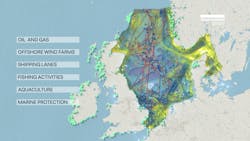Report predicts six-fold growth in North Sea wind energy by 2050
EXCLUSIVE CONTENT:
Market outlook: A new wave of growth is expected for the offshore wind industry
The next few years will see new entrants that are exploring offshore wind, including Azerbaijan, Brazil, Canada, Colombia, India, Oman, the Philippines, Sri Lanka, and Trinidad and Tobago.
By MarketsandMarkets
A DNV-produced report predicts that offshore wind developments will occupy 9% of the North Sea area by 2050.
"North Sea Forecast: Ocean’s Future to 2050" also calls for new policies to promote cross-industry collaboration to ease pressures on spatial planning. The coasts of the North Sea, it points out, are the setting for Europe’s busiest ports, while the sea produces most of the continent’s offshore energy and has its largest fisheries.
DNV estimates that offshore wind capacity in the North Sea will increase six-fold by 2050 to 214 GW, with the area claimed for offshore wind developments exceeding 60,000 sq km by the same point.
In total, it adds, ocean infrastructure will occupy 23% of the North Sea area in water depths of 0-50 m and at distances 2-50 km from the shore.
However, the currently projected growth in offshore wind is not sufficient to meet the green energy targets of the Ostend Declaration for the North Sea. DNV advocates action on supply chain bottlenecks and calls for North Sea ports to quadruple the capacity of facilities dedicated to offshore wind construction, with more vessels to install and service the turbines.
By 2050, the report’s authors claim, the North Sea’s oil production will decrease to 800,000 bbl/d, less than 20% of current levels. Gas production over the same period is forecast to fall to 60 Bcm/d, nearly two-thirds down on the region’s gas output last year.
Want more offshore wind content?
Renewable Energy newsletter
This monthly e-newsletter provides updates on new technology, projects and policy for the development of offshore renewable energy from wind, waves, solar, and other resources.
